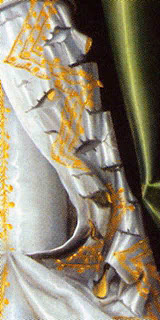 This is Lady Diana Cecil, Countess of Oxford, in an early 1600's portrait attributed to William Larkin. A close-up was featured on the cover of the December 2007 issue of The Magazine Antiques, so there was no missing what is going on with her dress. What exactly IS going on there? The front of the skirt and the over-sleeves appear to be slit, but obviously not left with raw edges. I want to know how they did that! I don't know a great deal about period dress, but still, I found this both fascinating and bizarre, especially for the time period. Any specialists out there that can enlighten us?
This is Lady Diana Cecil, Countess of Oxford, in an early 1600's portrait attributed to William Larkin. A close-up was featured on the cover of the December 2007 issue of The Magazine Antiques, so there was no missing what is going on with her dress. What exactly IS going on there? The front of the skirt and the over-sleeves appear to be slit, but obviously not left with raw edges. I want to know how they did that! I don't know a great deal about period dress, but still, I found this both fascinating and bizarre, especially for the time period. Any specialists out there that can enlighten us?The article featuring this painting, by the way, was about the evolution of the wearing of rings. This portrait was chosen to show how a valuable or too big of a ring was secured by a cord tied to the wrist so it wouldn't slip off and be lost. The original oil painting is part of the Suffolk Collection on view at Kenwood House in London. Click on any picture for a larger view.


3 comments:
Gosh, that is a simply amazing dress
I don't know heaps, but little snatches here and there...for example, the dress was slit to show wealth. Only those with heaps of money could afford luxurious underpinnings of silk etc and in order to show this off to others, the top fabric was slit. This can be seen in lots of photos of picutres throughout English history. All about ostentation. Check out Holbeins portraits for more, or any of those done during Queen Elizabeth 1's reign. Also because the top fabrics were so encrusted with jewels etc, they weren't washed and obviously would get hopelessly smelly. The undergarments were washed or changed more often. I don't think it would have made much difference though as most people thought washing would endanger health and didn't do it. Clothes spoke a lot about who you were and your status and certain fabrics and pelts - such as ermine - could only be afforded by the aristocracy and they wanted to show them off - probably also needed to show their wealth to be instantly recognised as authority in a crowd!
Thanks, Annabelle - I just knew one of you Brits would know something. ;-)
I think I had my first exposure to the hygiene of the era through the Romeo & Juliet movie of the early 1970's. I was pretty fascinated with the tie-on sleeves that could be removed and cleaned so the entire garment wouldn't have to go in the wash.
The slitting to show off the pricy fabric underneath makes sense. This just had such a modern feel to it (like the way the kids started purposely slitting their jeans), and all I could think of was the work it would take to enclose all those raw edges. Of course, everything back then was done by hand so it probably wasn't considered nearly the big deal that it would be today.
How in the world, btw, did they stand those ruffed collars? I choke just looking at them!
Post a Comment